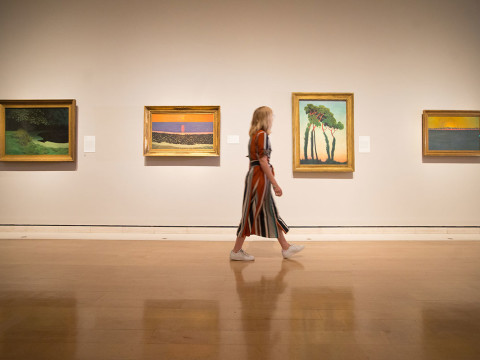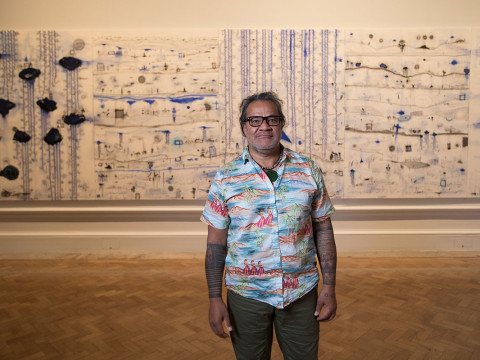
My studio life: Grayson Perry RA
By Tom Jeffreys
Published on 15 October 2014
We caught up with Grayson Perry RA as he moved into his new Islington Studio, where he told us about ceramics, motorbikes and why he wears cashmere socks.
Grayson Perry RA works in a variety of mediums but is best known as a ceramicist. There is a dissonance between the conventional forms of his vessels and the depictions that adorn them. He uses imagery and text to chronicle social concerns, his own formative experiences and to tell the story of his alter ego, Claire. The tone of his narratives is psychologically complex and often caustic. Although he uses traditional methods to make his pots, he employs a range of techniques, such as embossing and photographic transfers, to create intricate, animated surfaces.
Having worked for many years in Walthamstow, we caught up with the artist as he settled into a new studio in Islington.

"Welcome to my brand new Islington studio! We used to walk past here 20 years ago and think, ‘Wow, this would make a wonderful studio’. And now I've got it."

"The building was originally used as a watch factory, and you can still see signs of the belt-driven machinery. The next company here made decorative plaster moulding for theatres, and it was finally a small metal workshop. After that, it was used as a film set. With pale green, flaking paint, it was perfect for period drama murder scenes..."

"I do feel slightly embarrassed here. It feels like one of those YBA studios: they always have perfect white industrial studios. I’m not complaining though. Moving here has been the biggest change in my life – my work rate has gone up hugely. In Walthamstow I had to go home by four as it was simply too cold. Even here though, I swear by cashmere socks from November all the way through to about April."

"We had to hire cranes and knock down the front door to get these kilns out of my last studio. A man was walking past pushing a buggy and asked what was going on. So I told him I was moving to a new studio. 'Oh, it's a sad day for Walthamstow,' he said. Artists are the shock troops of gentrification, and Walthamstow is well on the way. ‘My work here is done,’ I told him!"

"The woman on top of the red kiln is my kiln goddess. Alan Measles got co-opted to look after the second one."

"For the tapestries, I start with a full-scale drawing and then use this to design them. I work with a production company called Factum Arte, who sent their Photoshop expert here for two days to give me a crash course. What's brilliant about it is that everything is contingent. Unlike real things, you can always go back to the beginning and start again."

"This is Kate Fox's Watching the English. I love this book, it's my Bible. Every time I meet a foreigner thinking of moving here I tell them to read it."

"I’m always referring to lots of different sources – my books are primary in my work. The green tile in front of these ones is a sketch for the Essex House that I'm doing with FAT and Living Architecture. They're going to be giant!"

"These terracotta stamps on the second shelf down are used for logos and other repeat images on my pottery. One of the first I made was a stamp of a hell’s angel. I’ve got thousands of them now."

"I use the magnifying glass to carve them."

"That’s one of my Tate Modern reliquaries hanging from the beams – it’s a piece of broken pot. You can buy it from their gift shop if you like."

"That cushion is ancient and full of pottery dust. There’s something of the little old lady in her conservatory about it."

"I’ve never owned a car. Bikes have always been part of my identity. Trannies do tend to overcompensate by doing very macho stuff. I’m getting to an age now where I’m thinking of buying a car – probably a red sports car, something exotic and embarrassing. "

"These leathers are the first thing I ever had specially made, when I was 29. I look at them now like the skin of my younger body. I could probably squeeze into them now, like some kind of middle-aged sausage."

"I bought this from Rachel Choi's student fashion show. It weighs a tonne: clearly, an awful lot of artificial fibres have gone into it! It might be the most bonkers thing I own."
See other interviews with artists and architects from our 'My studio life' series.
Related articles

Five minutes with Ryan Gander RA
13 June 2022

Video: Lucian Freud's painting technique
19 November 2019

Video: Félix Vallotton in 60 seconds
17 July 2019

Artists of Oceania: John Pule
29 November 2018

Video: Egon Schiele in 60 seconds
20 November 2018

Artists of Oceania: Mata Aho Collective
16 November 2018